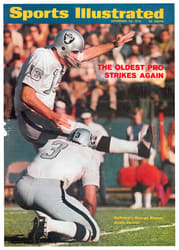
Goodby Billy and Hello Willy
Do not get your hopes up. Better not make any bets. But you might consider this fact: the misguided optimism of yesterday has departed, to be replaced by a sense of quiet determination on the U.S. Alpine ski team. The age of Willy Schaeffler has arrived, and with it comes a solid Teutonic pattern of things that promises stability—if not a steady stream of medals—for the next couple of years.
As everybody knows, the U.S. ski team has a long history of starting seasons with trumpet blasts heralding success, then fading into deep and depressing mediocrity. Mostly this aura of constant disappointment was due to the super salesmanship of former Alpine Director Bob Beattie: his ability to promote and raise hopes was superior to his team's basic ability to ski.
In addition, there are those who always have felt U.S. hopes of outskiing the Alpine nations will be doomed to mediocrity until participants are drawn from a wider pool of athletes. Give us some Jerry Wests, a Gale Sayers or two, some Johnny Benches and a John Havlicek and we'll beat the world—well, at least the French and Austrians. And as for direction, there are those who insist that U.S. ski racing won't really succeed until it inherits a coach with the bite and powers of a Vince Lombardi.
It has not come to that. The racers still look pretty much the same, which is young, vigorous and bright. But the team as a unit is pointed in a new direction, and if Schaeffler is neither a Beat-tie nor a Lombardi he is perhaps something equally interesting, somewhere between the two.
Willy Schaeffler is one tough gentleman. At 54, his blond curls are growing ever more sparse and the network of wrinkles is creeping farther beyond his deep-set blue eyes. But there is a lithe-ness to his step, a drollness to his wit and a hint of steel in his moves. There is about this rugged old former Bavarian shepherd boy a quality of experience, of Old World common sense and authority, and one must suspect that perhaps the U.S. Ski Association could not have selected a better man for these uncertain times. Out of the depressing tempests of politics, personal feuds, manufacturers' unvarnished avarice and damaged spirits that buffeted the American team last year, the USSA convinced Willy Schaeffler he should head the Alpine program through this season and next—which, of course, will include the 1972 Winter Olympics at Sapporo.
As far as sheer technical achievement by a ski coach, no one can match Willy's record at the University of Denver, where his teams have won no fewer than 13 of the total 17 NCAA skiing championships. Indeed, since he arrived at Denver in 1948 (following a boyhood with the sheep of Bavaria, a teen-age period as one of the finest junior skiers in Germany and an early manhood in the Wehrmacht doing bloody battle along the Russian front), Schaeffler's teams have won a fantastic total of 120 of the 123 meets they have entered. And as Willy has been often heard to cry out during a radiant postmeet celebration: "It iss fun to vin!"
Such fun has been notably rare among U.S. Alpine skiers over the years. As Willy gathered his brood about him in Colorado last week for the final preparation before the painfully long World Cup season that starts Dec. 12 in Italy, he spoke with what could only be described as finely controlled optimism: "We do the best we can and that could be pretty good. I tell these young kids, 'Look, we must hurry now. You may have 10 years to ski race, but I have only two years to succeed and we must not disappoint me.' "
At the moment, the best possibility for keeping Willy from being grandly disappointed is—as usual—the women's team. The coach of the girls in the new regime is Hank Tauber, 29, son of a wealthy glovemaker out of Gloversville, N.Y., for three years an assistant women's coach when Beattie ran the show and last season a racer-chaser on the European circuit for Head Ski Co. Tauber is effusively optimistic: "American girls are potentially better than any team in the world right now." That has a familiar ring. Still, of the eight-member team he would take to Europe, the sisters Marilyn and Barbara Cochran of Vermont—both medal winners at last year's world championships in Val Gardena—and Karen Budge of Wyoming are all ranked in or near the top seeding for slalom, giant slalom and downhill.
And what of the men? For the first time in almost a decade there is no longer the stouthearted Billy Kidd, shaggy-haired and intense, spilling over with promise and hope, but doomed—again and again—to wrench that frail ankle or snap a bone and somehow derail himself during a season. Is there a new Billy Kidd coming up? "Well, ah," said the diplomatic Herr Schaeffler, "maybe we cannot get along well without Billy's leadership and his mind, but we do not need Billy's injuries. Billy did what he could last year. He reached his peak—he squeezed everything he could from himself when he won the gold medal for the combined in Val Gardena. He could really do nothing more but retire. I do not think he would have done anyone any favors by coming back."
Without Billy Kidd the U.S. team is hard put for star-caliber names and possibly for any consistent world-class performances. Back from last year are Spider Sabich, Eric Poulsen, Bob Cochran, Hank Kashiwa and Rick Chaffee (the last two have been declared eligible since they rid themselves of ski-company contracts, which caused such furor last spring). The new name most mentioned is that of Steve Lathrop, 19, a strapping soccer player and graceful slalom skier from Middlebury College. In Val Gardena young Lathrop, just up from the B team, burst into dazzling, if short-lived, display by finishing third in the first run of the slalom. Unhappily, he fell on the second run. But he is bigger and stronger this year and is considered to be the brightest prospect on the team.
Still, whatever the American men manage to do this season they will find themselves in an enormously classy arena of world competition. They must face Patrick Russel, Jean-No√´l Augert and Alain Penz of France, Gustav Th√∂ni of Italy and Bernard Russi of Switzerland and—here he comes again—Karl Schranz. It is true: though the incomparable Austrian declared his retirement last spring after he won his second straight World Cup, he has jauntily announced from his pension in St. Anton that he is planning to compete once again.
But the current fortunes of Karl Schranz have not yet affected the world of Willy Schaeffler and the U.S. ski team. For the moment Willy is in a struggle to rebuild from the shambles of morale and performance left by some of his predecessors. For a time the USSA was run by an assortment of Major Hooples. That period seems to be over now that a bright IBM executive named Charles Gibson is the new USSA president. But there is precious little money for the team to go racing on, $201,910 to be exact, the smallest budget in several seasons.
Still Schaeffler is philosophical: "We are trying not to leave out one damn thing to make the kids ready for the season. Unless it costs big money. Then we leave it out."
Beyond the usual summer conditioning at Mammoth Mountain in California, at Portillo, Chile and at Thredbo in Australia, Schaeffler has instituted an intensive battery of psychological tests for the kids. If nothing else will improve, at least their vocabularies will, for the entire team is talking casually these days of kinesiology, aerobic and anaerobic organisms, of cardiovascular readouts, agility quotients and psycho-cybernetics (a kind of Zen for technocrats). Willy also has deep-think detailed letters from each team member's parents and ex-coaches, outlining observations about the kid's motivational drives, psychological hang-ups and habits, good and bad.
Schaeffler has injected a sense of firm control all right. As symbolic of the change as anything is the software-goods revolution around the team. In 1969-70 a full snafu set in over the question of uniforms. The team wound up traveling the World Cup circuit dressed like—well, as Schaeffler puts it, "They looked like they were all refugees from a Greek earthquake." Not now. The racers have been practically inundated in stylish piles of clothing—much of it pieces they have designed themselves, then have had tailor-fit to order. They have travel sweaters and training sweaters and events sweaters, Stars-and-Stripesy warmup suits, a one-piece racing suit with a muted wet look, red-white-and-blue hats, white racing gloves with blue stars on the knuckles and party pants suits for the girls.
Win or lose, U.S. skiers will look nice and, with the tough Willy Schaeffler around, maybe a few of them may even learn that it really iss fun to vin!
PHOTO
SURROUNDED BY HIS SKIING BROOD, SCHAEFFLER SUMMONS UP A WINNING SMILE

